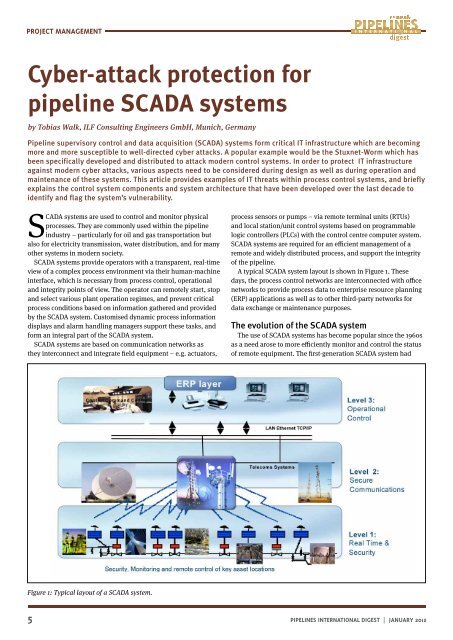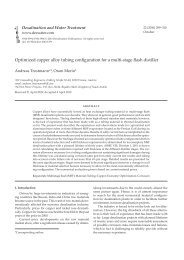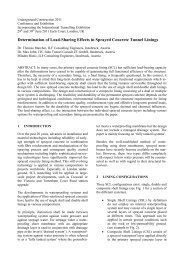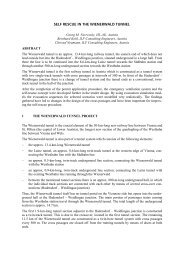Cyber-attack protection for pipeline SCADA systems - ILF Consulting ...
Cyber-attack protection for pipeline SCADA systems - ILF Consulting ...
Cyber-attack protection for pipeline SCADA systems - ILF Consulting ...
Create successful ePaper yourself
Turn your PDF publications into a flip-book with our unique Google optimized e-Paper software.
ProJect management<br />
<strong>Cyber</strong>-<strong>attack</strong> <strong>protection</strong> <strong>for</strong><br />
<strong>pipeline</strong> <strong>SCADA</strong> <strong>systems</strong><br />
by Tobias Walk, <strong>ILF</strong> <strong>Consulting</strong> Engineers GmbH, Munich, Germany<br />
Pipeline supervisory control and data acquisition (<strong>SCADA</strong>) <strong>systems</strong> <strong>for</strong>m critical IT infrastructure which are becoming<br />
more and more susceptible to well-directed cyber <strong>attack</strong>s. A popular example would be the Stuxnet-Worm which has<br />
been specifically developed and distributed to <strong>attack</strong> modern control <strong>systems</strong>. In order to protect IT infrastructure<br />
against modern cyber <strong>attack</strong>s, various aspects need to be considered during design as well as during operation and<br />
maintenance of these <strong>systems</strong>. This article provides examples of IT threats within process control <strong>systems</strong>, and briefly<br />
explains the control system components and system architecture that have been developed over the last decade to<br />
identify and flag the system’s vulnerability.<br />
<strong>SCADA</strong> <strong>systems</strong> are used to control and monitor physical<br />
processes. They are commonly used within the <strong>pipeline</strong><br />
industry – particularly <strong>for</strong> oil and gas transportation but<br />
also <strong>for</strong> electricity transmission, water distribution, and <strong>for</strong> many<br />
other <strong>systems</strong> in modern society.<br />
<strong>SCADA</strong> <strong>systems</strong> provide operators with a transparent, real-time<br />
view of a complex process environment via their human-machine<br />
interface, which is necessary from process control, operational<br />
and integrity points of view. The operator can remotely start, stop<br />
and select various plant operation regimes, and prevent critical<br />
process conditions based on in<strong>for</strong>mation gathered and provided<br />
by the <strong>SCADA</strong> system. Customised dynamic process in<strong>for</strong>mation<br />
displays and alarm handling managers support these tasks, and<br />
<strong>for</strong>m an integral part of the <strong>SCADA</strong> system.<br />
<strong>SCADA</strong> <strong>systems</strong> are based on communication networks as<br />
they interconnect and integrate field equipment – e.g. actuators,<br />
Figure 1: Typical layout of a <strong>SCADA</strong> system.<br />
process sensors or pumps – via remote terminal units (RTUs)<br />
and local station/unit control <strong>systems</strong> based on programmable<br />
logic controllers (PLCs) with the control centre computer system.<br />
<strong>SCADA</strong> <strong>systems</strong> are required <strong>for</strong> an efficient management of a<br />
remote and widely distributed process, and support the integrity<br />
of the <strong>pipeline</strong>.<br />
A typical <strong>SCADA</strong> system layout is shown in Figure 1. These<br />
days, the process control networks are interconnected with office<br />
networks to provide process data to enterprise resource planning<br />
(ERP) applications as well as to other third-party networks <strong>for</strong><br />
data exchange or maintenance purposes.<br />
The evolution of the <strong>SCADA</strong> system<br />
The use of <strong>SCADA</strong> <strong>systems</strong> has become popular since the 1960s<br />
as a need arose to more efficiently monitor and control the status<br />
of remote equipment. The first-generation <strong>SCADA</strong> system had<br />
5 PiPelines international digest | JanUarY 2012
ProJect management<br />
‘monolithic’ system architecture and was based on redundant<br />
mainframe computers. These mainframe computers collected<br />
all process data from the field and hosted a real-time process<br />
database. At that time, computer networks did not exist and<br />
communication protocols with RTUs were often of a proprietary<br />
type. <strong>SCADA</strong> <strong>systems</strong> were independent, stand-alone <strong>systems</strong><br />
with no connectivity to other <strong>systems</strong>.<br />
The second-generation <strong>SCADA</strong> system distributed processing<br />
across multiple stations which communicated via a local area<br />
network (LAN) in real time with each other. Each station was<br />
responsible <strong>for</strong> its dedicated tasks which significantly reduced<br />
the per<strong>for</strong>mance, capacity and costs of the required computer<br />
hardware compared with the mainframes of the first generation.<br />
However, the network protocols utilised were still mostly<br />
proprietary and optimised <strong>for</strong> real-time applications, quick<br />
response times and redundancy. As these networks were still<br />
being used exclusively by <strong>SCADA</strong> <strong>systems</strong>, data security and data<br />
encryption was not an issue at the time. Only very few people<br />
beyond the developers and hackers knew enough to determine<br />
how secure a <strong>SCADA</strong> installation really was, and they had no<br />
interest to flag or discuss the status quo of its security.<br />
The third-generation <strong>SCADA</strong> system is based on open-system<br />
architecture rather than a vendor-controlled proprietary<br />
environment. The <strong>SCADA</strong> system utilises open standards and<br />
protocols, thus distributing functionality across a wide area<br />
network (WAN) rather than a LAN. It is easier to connect third<br />
party peripheral devices, such as printers or hard disks, to open<br />
architecture. WAN protocols such as internet protocol (IP) are<br />
used <strong>for</strong> communication between the operator master station and<br />
communications equipment.<br />
Due to the use of standard protocols and the fact that many<br />
networked <strong>SCADA</strong> <strong>systems</strong> are now also accessible from the<br />
internet, the <strong>systems</strong> are potentially vulnerable to remote cyber<br />
<strong>attack</strong>s. On the other hand, the use of standard protocols and<br />
security techniques means that standard security improvements<br />
are applicable to <strong>SCADA</strong> <strong>systems</strong>, assuming they receive timely<br />
maintenance and updates.<br />
• Proprietary <strong>systems</strong><br />
• Individual customised solutions<br />
• Small quantities/number of installations<br />
• Vendor-specific communication protocols<br />
• High development costs<br />
• High system investment costs<br />
<strong>SCADA</strong> <strong>systems</strong> have been a reality <strong>for</strong> decades, but over<br />
time, market developments have migrated its infrastructure from<br />
proprietary, obscure and isolated <strong>systems</strong> toward standardised,<br />
documented and connected <strong>systems</strong> (see Figure 2).<br />
Conflicting cultures of IT security<br />
While technologies such as ethernet and TCP/IP allow <strong>for</strong><br />
significant cost savings and improved interfacing <strong>for</strong> industry, it<br />
is important to understand that their origins are derived from a<br />
culture very different from the process control provided by <strong>SCADA</strong><br />
<strong>systems</strong>. Even a new internet user can spot these differences in<br />
terms of reliability; occasional failures are common and tolerated<br />
on the internet while most control <strong>systems</strong> are expected to<br />
operate <strong>for</strong> months, if not years, without interruption. Similarly,<br />
the tradition of beta testing many new internet products in the<br />
field and recovering from problems by simply rebooting servers or<br />
switches contrasts sharply with standard <strong>SCADA</strong> practices. This is<br />
not surprising since the risk impact of outages on the internet are<br />
typically loss of data, while outages in the process environment<br />
will certainly result in loss of production and may even cause loss<br />
of equipment or life.<br />
The internet culture and its created technologies are based<br />
on the idea that per<strong>for</strong>mance is paramount and outages, while<br />
undesirable, are acceptable. This is clearly not true <strong>for</strong> industrial<br />
process control <strong>systems</strong>. These differences in expectations are<br />
briefly summarised within Table 1 and need to be kept in mind<br />
when implementing solutions from the internet world within an<br />
industrial control environment.<br />
Security issues within <strong>SCADA</strong> <strong>systems</strong><br />
Most companies are reluctant to report cyber <strong>attack</strong>s or even<br />
internal accidents as this can blemish their reputation. Incidents<br />
involving health, safety or environmental degradation may<br />
even jeopardise their company’s license to operate. The British<br />
Columbia Institute of Technology (BCIT) maintains an industrial<br />
cyber security incident database that tracks incidents involving<br />
process control <strong>systems</strong> in all sectors of manufacturing.<br />
1980 1990 2000 2010<br />
Figure 2: Development of <strong>SCADA</strong> system components.<br />
• Standardised kits and <strong>systems</strong><br />
• Out of the box solutions<br />
• Large quantities/number of installations<br />
• Standardised communication protocols<br />
• Interoperability between different vendors<br />
• Reduced development costs<br />
6 PiPelines international digest | JanUarY 2012<br />
Time
ProJect management<br />
Reliability<br />
Internet environment Process control environment<br />
Occasional failures tolerated<br />
Beta test in the field acceptable<br />
The affected parties reported that <strong>for</strong> 50 per cent of these registered<br />
incidents, their losses exceeded $US1 million. The Carnegie Mellon<br />
Software Engineering Institute reports at least two cases with<br />
financial losses in the range of “tens of millions of dollars”.<br />
According to a report written by IBM’s Global Security<br />
Intelligence team “the global IT threat landscape is going through<br />
a fundamental shift, or evolution, in cyber crime from pervasive<br />
global outbreaks to smaller, stealthier <strong>attack</strong>s targeted at specific<br />
organisations”. This statement can be easily supported by the<br />
sophistication of hacker tools (refer to Figure 3).<br />
The following non-exhaustive list highlights the risk potential<br />
using real examples:<br />
• In July 2010, the computer worm Stuxnet was discovered.<br />
This was the first identified malware to subvert the PLCs<br />
of industrial control <strong>systems</strong>. The worm initially spreads<br />
indiscriminately, but includes a highly specialised malware<br />
payload that is designed to target only Siemens <strong>SCADA</strong><br />
<strong>systems</strong> that are configured to control and monitor specific<br />
industrial processes.<br />
Outages intolerable<br />
Thorough quality assurance testing expected<br />
Risk impact Loss of data Loss of production, equipment, life<br />
Per<strong>for</strong>mance<br />
Risk management<br />
Security<br />
High throughput demanded<br />
High delay and jitter accepted<br />
Recover by reboot<br />
Safety is a non-issue<br />
Most sites insecure<br />
Little separation between intranets on same site<br />
Focus is central server security<br />
Table 1: Differences between internet and process control environments.<br />
Figure 3: The sophistication of hacker tools.<br />
Modest throughput acceptable<br />
High delay is a serious concern<br />
Fault tolerance essential<br />
Explicit hazard analysis expected<br />
Tight physical security<br />
Isolated office network from plant network<br />
Focus is edge control device stability<br />
Technical knowledge<br />
required <strong>for</strong> defending<br />
Sophistication<br />
of hacker tools<br />
Technical<br />
knowledge<br />
required<br />
<strong>for</strong> hacking<br />
• In 2004, a disgruntled <strong>for</strong>mer <strong>SCADA</strong> supervisor caused the<br />
release of nearly 264,000 gallons of raw sewage into the<br />
sewer system of an Australian city.<br />
• The safety monitoring system of Ohio’s Davis-Besse nuclear<br />
power plant was offline <strong>for</strong> five hours due to the Slammer<br />
Worm in January 2003.<br />
• In 2000, the Russian government announced that hackers<br />
succeeded in gaining control of the Gazprom <strong>pipeline</strong><br />
network.<br />
• In 1995, at TransCanada PipeLines Ltd, disabled low<br />
pressure and temp alarms caused two <strong>pipeline</strong>s to rupture<br />
and catch fire at compressor station #30.<br />
From these examples, the following general cyber <strong>attack</strong><br />
scenarios can be derived:<br />
1. Issuing unauthorised commands to control equipment;<br />
2. Sending false in<strong>for</strong>mation to a control system operator that<br />
initiates inappropriate actions;<br />
3. Disrupting control system operation by delaying or blocking<br />
the flow of in<strong>for</strong>mation through the control network;<br />
7 PiPelines international digest | JanUarY 2012
ProJect management<br />
4. Making unauthorised changes to control system software<br />
to modify alarm thresholds or other configuration settings;<br />
and,<br />
5. Rendering resources unavailable by propogating<br />
malicious software (e.g. a virus, worm, Trojan horse)<br />
through the control network.<br />
These scenarios can be justified as realistic risk potentials<br />
as common <strong>SCADA</strong> communication protocols provide no<br />
authentication and there<strong>for</strong>e no confidentiality. Furthermore,<br />
<strong>SCADA</strong> <strong>systems</strong> are based on common hardware and operating<br />
software and are vulnerable to viruses. However, <strong>SCADA</strong><br />
<strong>systems</strong> do rely on real-time per<strong>for</strong>mance, and improperly<br />
selected and configured antivirus application software could<br />
degrade a <strong>SCADA</strong> system’s per<strong>for</strong>mance enough to make the<br />
system useless or dangerous.<br />
These concerns are reflected by <strong>SCADA</strong> system end users,<br />
which is one of the reasons why antivirus software has not<br />
been more widely adopted within these <strong>systems</strong>. Patch<br />
management is another known problem within the IT world;<br />
changing anything in the continuous operating <strong>SCADA</strong> world<br />
is a challenging task that is often significantly delayed or never<br />
per<strong>for</strong>med during the lifetime of these <strong>systems</strong>.<br />
Specific security guidelines<br />
A single security product or technology cannot adequately<br />
protect an industrial control system, so a multiple-layer<br />
strategy involving two (or more) different overlapping security<br />
mechanisms is desired to avoid a vulnerability in one technique<br />
from allowing a compromise.<br />
Securing a <strong>SCADA</strong> system is based on a combination of<br />
effective security policies and a properly configured set of<br />
technical security controls. An initial list of topics, which needs<br />
to be considered within that respect are:<br />
• A security plan with security policies needs to be in place<br />
to ensure safe and reliable operations.<br />
• Security issues need to be addressed throughout the<br />
lifecycle of the <strong>SCADA</strong> system, starting from architecture,<br />
through to procurement and installation, and followed<br />
up during maintenance and decommissioning.<br />
• The network topology <strong>for</strong> the process control network<br />
should be based on separate dedicated communication<br />
layers protected by firewalls. The most critical<br />
communication links should be hosted within the most<br />
secure and reliable layer.<br />
• Security techniques, such as encryption, should be<br />
applied to <strong>SCADA</strong> communications and data storage.<br />
• Wireless networks have an elevated level of security<br />
concern within a process control network; this needs<br />
to be carefully evaluated and assessed <strong>for</strong> risks prior<br />
to installation. Wireless network technology changes<br />
frequently, and its security depends on the ability to stay<br />
current and protected.<br />
• Process control and corporate office networks should be<br />
logically separated through the use of a DMZ network<br />
architecture, which prevents direct traffic between<br />
these networks.<br />
• All critical components need to be redundant and based<br />
on redundant networks.<br />
• The process control system design needs to be fault<br />
tolerant to prevent catastrophic cascading events. System<br />
failures should shut down the plant in a secure manner.<br />
• Physical access to the process control network and<br />
devices should be restricted. Disable unused ports and<br />
services on system devices and verify that this will not<br />
impact operations.<br />
• <strong>SCADA</strong> system user privileges should be restricted<br />
only to those that are required to per<strong>for</strong>m each person’s<br />
job (i.e. establishing role-based access control and<br />
configuring each role based on the principle of least<br />
privilege).<br />
• The use of strong authentication mechanisms <strong>for</strong> users of<br />
the process control network as well as <strong>for</strong> the corporate<br />
office network should be considered and kept separate<br />
(i.e. process control network accounts do not use<br />
corporate network user accounts). Disable any default<br />
user accounts and replace simple vendor passwords.<br />
• Access rights given to the system vendor should be<br />
removed once the work has been completed.<br />
• Security controls such as antivirus software and file<br />
integrity checking software should be implemented<br />
where technically feasible in order to prevent, deter,<br />
detect, and mitigate the introduction, exposure and<br />
propagation of malicious software to, within, and from<br />
the process control network.<br />
• Security patches should be deployed after all patches<br />
under field condition have been tested on a test bed<br />
environment in a timely manner.<br />
References<br />
• API 1164 (2 nd edition, June 2009): Pipeline <strong>SCADA</strong><br />
Security<br />
• API Security Guidelines <strong>for</strong> the Petroleum Industry (3 rd<br />
edition, April 2005)<br />
• Germany’s Federal Office <strong>for</strong> In<strong>for</strong>mation Security:<br />
IT-Grundschutz<br />
• ISO/IEC 27001:2005 (issued October 2005): In<strong>for</strong>mation<br />
technology -- Security techniques -- In<strong>for</strong>mation security<br />
management <strong>systems</strong> -- Requirements<br />
• ISO/IEC 27002:2005 (issued July 2007): In<strong>for</strong>mation<br />
technology - Security techniques - Code of practice <strong>for</strong><br />
in<strong>for</strong>mation security management<br />
• Journal of Computers, Vol. 5, No. 3, March 2010: “A<br />
Risk-Assessment Model <strong>for</strong> <strong>Cyber</strong> Attacks on In<strong>for</strong>mation<br />
Systems”<br />
• NIST Special Publication 1058 (Version 1.0, Sept. 2006):<br />
Using Host-based Anti-virus Software on Industrial<br />
Control Systems: Integration Guidance and a Test<br />
Methodology <strong>for</strong> Assessing Per<strong>for</strong>mance Impacts<br />
• VDE 2004 Congress, Berlin, October 2004 “The Myths<br />
and Facts behind <strong>Cyber</strong> Security Risks <strong>for</strong> Industrial<br />
Control Systems”<br />
• www.wikipedia.org<br />
8 PiPelines international digest | JanUarY 2012
















